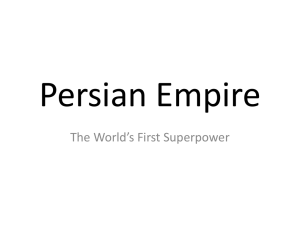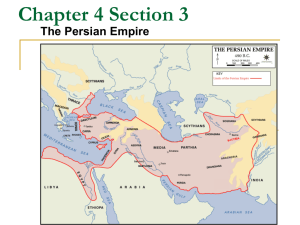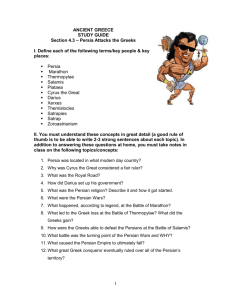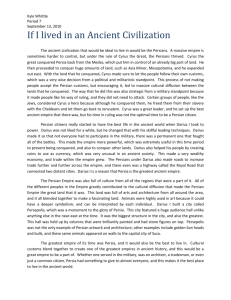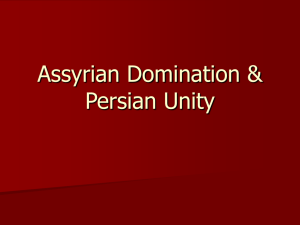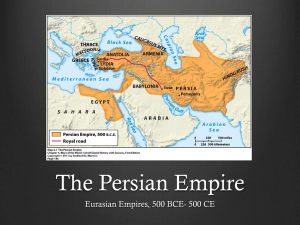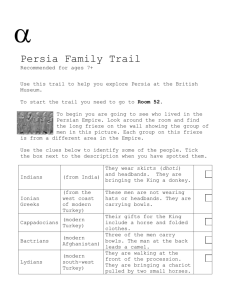Persia Unites many Lands
advertisement
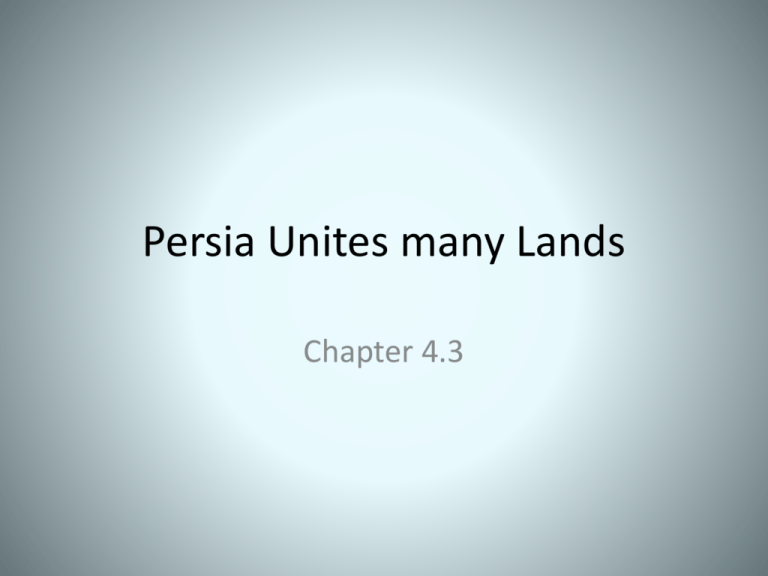
Persia Unites many Lands Chapter 4.3 Main Ideas • Geography- Persia’s location between Mesopotamia and India was a bridge between eastern and western Asia • Government- Cyrus used a policy of toleration • Government- To better govern, Persia divided its lands into smaller units and developed an imperial bureaucracy. • Religion- Persia practiced Zoroastrainism Essential Question • What was the land of Persians like? Mountains, Deserts, and a Plateau • The lands of the Medes included Persians in modern-day Iran • Mountain ranges isolated Persia from the rest of the Fertile Crescent • Iron, copper, semiprecious gems found in the land Persian Empire 500 B.C. Cyrus Founds the Persian Empire • • • • Essential Questions: What was the rule of Cyrus like? Why can Cyrus be considered a wise emperor? How did Darius control his empire? Why did Darius divide the empire? The Rise of Persia • Unlike the Assyrians who used force to control a vast empire, the Persians would use tolerance and diplomacy. • After the Medes overthrew the Assyrian Empire in 612 B.C., they joined the Persians as the other major power in the region. • Soon, the Persians would dominate even the Medes People Cyrus the Great Ruled from 559 to 530 BCE, he started the Persian Empire and was known for treating his subjects well Darius Ruler of Persian Empire who reorganized it into 20 provinces (satrapies) to make it run better. Xerxes Son of Darius, he vowed revenge against the Athenians and led the Persians in a new invasion of Greece in 480 BCE People Themistocles Athenian general who created the strategy to fight against Xerxes and his Persians. (cut off the shipments of food brought in by boat and starve them out) Herodotus (p.135) Author of History of the Persian Wars, he described the conflict as one between freedom and dictatorship. Persian Wars is considered to be the first real history in Western civilization Cyrus the Great • Persian King that began a conquest of several neighboring kingdoms in Iran. • Conquered the entire Fertile Crescent and most of Anatolia • Although his military might was great, Cyrus would be remembered for his method of governing. Differences in Leadership Sennacherib • Burned and sacked 89 cities and 820 villages • Killed most of the inhabitants, beheading many. • Chose Assyrian or Assyrianfriendly kings to govern conquered lands. • Levied heavy taxes on the conquered. Cyrus • His generals enforced strict discipline against looting and burning. • Honored the local customs and religions of the conquered • Knelt to pray in the local temple. • Babylon opened it’s gates for Cyrus to enter, a bloodless victory for Cyrus • Allowed the Jews to return to Jerusalem. Persian Rule and Religion After Cyrus’ death, his successors had both successes and failures. Cambyses: • Cyrus’ son • Extended the Persian Empire into Egypt, but scorned the Egyptian religion. • Destroyed many of the Egyptian statues of their idols and gods • After his death, many rebellions broke out. Darius • Started as the king’s bodyguard • With the help of soldiers, claimed the throne. • Expanded the empire , over 2500 miles east to west • Divided his empire into 20 provinces. Places Persia Area that is now southwestern Iran Marathon A city located close to Athens, and the site of one of the first battles between Persia and the Greeks. Thermopylae A narrow pass through the mountains, and the location of an important battle during the 2nd Persian invasion. Places/Define Salamis a narrow strait and location of a naval battle in which the Greeks defeated the larger Persian ships Satrapies provinces(20 in number) in ancient Persia, created by Darius to make a more efficient government Satrap ruler of each province, he acted as judge, tax collector, chief of police, and recruiter for the army. All satraps answered to the king. Provinces and satraps • Darius divided his empire into 20 provinces. • These “nationalities”: – Practiced their own religion – Spoke their own language – Had their own laws • Although these groups had many freedoms, Darius still ruled absolutely. • Installed satraps, or governors, in each province, which ruled under his command • They were kept honest by inspectors, who he called his “eyes and ears” Keeping the Empire together • The Royal Road – Linked his empire together • Manufacturing coins – First use of standardized coins The Royal Road Persian Religion • Zoroaster: – Persian Prophet who lived around 600 B.C. – Helped people deal with the suffering and chaos they dealt with every day. • Taught that 2 armies fight for possession of your soul – Ahura Mazda leads the good army – Ahriman leads the bad • Each person, at their death, would be judged on their life. – Followers of Mazda would be lifted into paradise. – Followers of Ahriman would burn forever in a fiery pit. • Sound familiar? Summary • Persian kingdoms succeed due to trade • Cyrus the Great ruled the Persian Empire with policy of toleration • Darius formed provinces and appointed satraps • Zoroastrianism was the official religion of Persia Why it matters now? – Persians showed that lands ruled with policies of toleration could be stable and peaceful. • What is the political climate of this region today?
